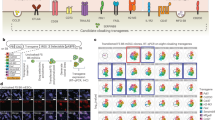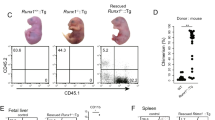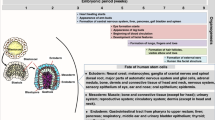Abstract
THE hypotheses advanced to account for the success of the foetus as an intra-uterine homograft in pregnancy have recently been reviewed by Billingham1. Three possible mechanisms have been suggested to explain the apparent lack of immunological reaction by the pregnant mother against the genetically foreign offspring with which she is in intimate contact2: (a) the antigenic immaturity of the foetus; (b) the immunological inertness of the mother; and (c) some form of anatomical separation of the foetus from the mother. It has, however, been shown that transplantation antigens appear early in embryonic life and that the mother, though pregnant, is fully capable of reacting against these antigens3–5. In addition, it has been shown that the uterus is not a specially privileged recipient site for prolonged homograft survival6,7.
This is a preview of subscription content, access via your institution
Access options
Subscribe to this journal
Receive 51 print issues and online access
$199.00 per year
only $3.90 per issue
Buy this article
- Purchase on Springer Link
- Instant access to full article PDF
Prices may be subject to local taxes which are calculated during checkout
Similar content being viewed by others
References
Billingham, R. E., New Eng. J. Med., 270, 667 and 720 (1963).
Medawar, P. B., Evolution, 7, 320 (1953).
Woodruff, M. F. A., Proc. Roy. Soc., B, 148, 68 (1957).
Terasaki, P. I., J. Embryol. Exp. Morphol., 7, 409 (1959).
Haskova, V., in Biological Problems of Grafting, 95, edit. by Albert, F., and Medawar, P. B. (Blackwell Scientific Publications, Oxford, 1959).
Schlesinger, M., J. Nat. Cancer Inst., 28, 927 (1962).
Poppa, G., Simmons, R. L., David, D. S., and Russell, P. S., Transplantation, 2, 496 (1964).
Simmons, R. L., and Russell, P. S., Ann. N.Y. Acad. Sci., 99, 717 (1962).
Simmons, R. L., and Russell, P. S., Amer. J. Obstet. Gynec., 85, 583 (1963).
Billingham, R. E., and Medawar, P. B., Brit. J. Exp. Biol., 28, 385 (1951).
Stimpfling, J. H., Transpl. Bull., 27, 109 (1961).
Simmons, R. L., and Russell, P. S., Transplantation, 2, 551 (1964).
Kirby, D. R. S., J. Embryol. Exp. Morph., 10, 496 (1962).
Kirby, D. R. S., Nature, 194, 785 (1962).
Author information
Authors and Affiliations
Rights and permissions
About this article
Cite this article
SIMMONS, R., RUSSELL, P. Histocompatibility Antigens in Transplanted Mouse Eggs. Nature 208, 698–699 (1965). https://doi.org/10.1038/208698a0
Issue Date:
DOI: https://doi.org/10.1038/208698a0
This article is cited by
Comments
By submitting a comment you agree to abide by our Terms and Community Guidelines. If you find something abusive or that does not comply with our terms or guidelines please flag it as inappropriate.



